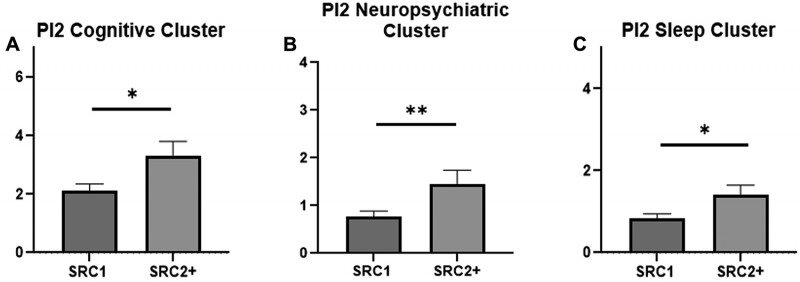![Comparison of mean (bars) and standard deviation (error bars) severity score for symptom clusters (cognitive cluster [A], neuropsychiatric cluster [B], and sleep cluster [C]) at the second postinjury test (PI2) between patients with one previous concussion (SR1) and those with multiple concussions (SRC2+). *p < 0.05; **p < 0.01. Credit: American Association of Neurosurgeons Effects of repetitive head trauma on symptoms of sport-related concussion](https://scx1.b-cdn.net/csz/news/800a/2023/effects-of-repetitive.jpg)
In an effort to understand the effects of multiple sport-related head injuries, researchers from the Department of Neurosurgery at the Icahn School of Medicine at Mount Sinai in New York City evaluated a large multicenter database of more than 25,000 Immediate Post-Concussion Assessment and Cognitive Testing (ImPACT) results obtained in young student-athletes from 2009 to 2019. In the study, patients with a history of multiple concussions reported greater cognitive, sleep, and neuropsychiatric symptoms, but not migraine symptoms. This important distinction may help guide decision-making regarding patient monitoring and return to play.
Detailed findings of this work are described in the article “Effects of repetitive head trauma on symptomatology of subsequent sport-related concussion” led by Addison Quinones, a medical student at Icahn School of Medicine at Mount Sinai, and published today (May 9) in the Journal of Neurosurgery: Pediatrics .
“The study of sports-related concussion has become of increased interest among both amateur and professional athletes,” says Quinones. “Despite our advancements, many questions remain regarding both long and short-term sequelae on athletes.”
“In the current study, data from adolescent athletes suggest that the number of prior concussions may affect presenting symptomatology, which may guide medical personnel in athlete management and recovery,” explains senior author Tanvir Choudhri, MD, Associate Professor of Neurosurgery at the Icahn School of Medicine at Mount Sinai, and Co-Director of the Neurosurgery Spine Program at the Mount Sinai Health System.
Adolescents are often encouraged to participate in organized sports by their parents, owing to the well-known physical and sociological benefits. This increase in involvement in youth sports is also coupled with an increase in the concussion incidence, which is a considerable concern among parents and medical professionals. Approximately 20% of the 1.7 million pediatric concussions in the United States are related to sports participation.
In this study, the authors evaluated data from a multicenter database of more than 25,000 ImPACT assessments. ImPACT prompts the participant to rate the severity of 22 neurocognitive symptoms. All included participants were 12- to 22-year-old student-athletes who reported their previous number of concussions and completed a baseline ImPACT assessment prior to injury, in addition to a first postinjury test (PI1) and second postinjury test (PI2).
Patients who previously reported one concussion (SRC1) were compared with patients with multiple prior concussions (SRC2+), with both groups of patients having similar characteristics at baseline. Multivariate analysis showed minimal differences between groups at PI1, and less-severe headache symptoms in SRC2+ patients was the only significant finding. However, as time progressed, greater differences between groups were noted: SRC2+ patients had increased cognitive, sleep, and neuropsychiatric symptoms—but not migraine symptoms—compared with SCR1 patients at PI2.
The distinction in headache symptoms over time is an important finding, as headache symptoms are easily noted by patients, parents, and medical professionals. Understanding how symptoms change in student-athletes with multiple concussions could help predict long-term consequences and inform improved guidelines regarding return to play and academics.
More information:
Effects of repetitive head trauma on symptomatology of subsequent sport-related concussion. Journal of Neurosurgery: Pediatrics, published online, ahead of print, May 9, 2023; DOI: 10.3171/2023.2.PEDS237. www.newswise.com/pdf_docs/1682 … rsion_online_pdf.pdf
Journal information:
Journal of Neurosurgery: Pediatrics
Source: Read Full Article



